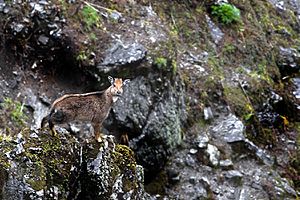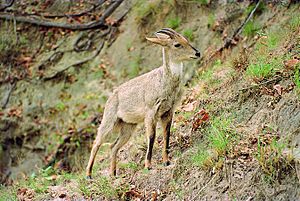Himalayan goral facts for kids
The Himalayan goral (Naemorhedus goral), also called the gray goral, is a type of wild goat-like animal. It belongs to the Caprinae family, which includes goats and sheep. This small animal has rough hair and horns that look like cylinders. It is a ruminant, meaning it chews its cud, just like cows. Himalayan gorals live in the Himalayas mountains.
Contents
What They Look Like
Himalayan gorals are about 95 to 130 cm (37 to 51 in) (3 to 4 feet) long. They weigh between 35–42 kg (77–93 lb) (77 to 93 pounds). Their fur is gray or gray-brown. They have tan legs and lighter patches on their throats. A single dark stripe runs down their back.
Male gorals have short manes on their necks. Both males and females have horns that curve backward. These horns can grow up to 18 cm (7.1 in) (7 inches) long. Gorals are different from their close relatives, the serows. Gorals do not have special glands below their eyes.
Where They Live


Himalayan gorals live in the forests of the Himalayas. You can find them in countries like Bhutan, northern India (including Sikkim and Arunachal Pradesh), Nepal, and southern Tibet. They might also live in western Myanmar.
They live on the southern slopes of the Himalayas. This area stretches from Jammu and Kashmir to eastern Arunachal Pradesh. In India and Nepal, they live at heights from 900 to 2,750 m (2,950 to 9,020 ft) (about 3,000 to 9,000 feet) above sea level. In Pakistan, they have been seen even higher, from 1,000 to 4,000 m (3,300 to 13,100 ft) (about 3,300 to 13,000 feet).
A group of gorals usually uses an area of about 40 ha (0.40 km2) (0.4 square kilometers). During mating season, males claim smaller areas of 22–25 ha (0.22–0.25 km2) (0.22 to 0.25 square kilometers) as their own.
Daily Life and Habits
Himalayan gorals often live in small groups of four to twelve animals. Sometimes, they live in pairs. Older males often live alone. These animals are crepuscular, which means they are most active during early morning and late evening.
After eating in the morning, a goral often drinks water. Then it rests on a rock ledge for the rest of the day. They mainly eat leaves and soft parts of plants, especially grasses.
Gorals are very quick and can run fast. Their gray and brown fur helps them blend in with their surroundings. This makes them very hard to spot, especially when they are lying still. However, other animals hunt them. If a goral feels threatened, it will make hissing or sneezing sounds.
Reproduction and Life Cycle
Himalayan gorals can live for 14 or 15 years. Female gorals are pregnant for about 170 to 218 days. They usually give birth to one baby at a time. The young gorals drink their mother's milk for about 7 or 8 months. They become old enough to have their own babies when they are about 3 years old.
See also
 In Spanish: Goral del Himalaya para niños
In Spanish: Goral del Himalaya para niños



